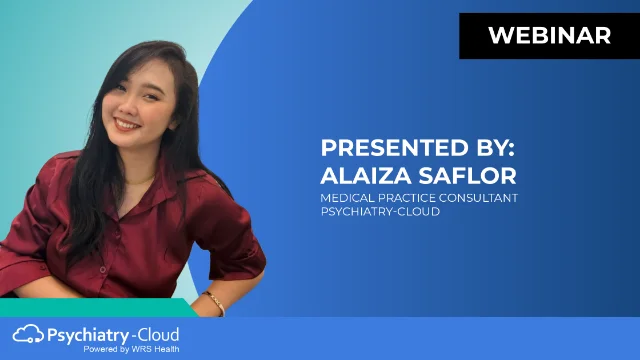Key Takeaways
- AI tools built for psychiatry allow clinicians to focus more on meaningful, person-centered care.
- Client vs. patient language choices matter more in an AI-supported care model, where clarity, trust, and shared roles influence treatment outcomes.
- Modern tech can support psychiatrist-patient relationships with AI scribes, smart workflows, and documentation tools.
- Learn how AI-enabled psychiatry platforms can improve outcomes without compromising patient connection.
In psychiatric care, the provider-patient relationship is the cornerstone of healing. For years, mental health professionals have debated whether to refer to someone as a “client” or “patient.” And this distinction goes beyond semantics. It reflects how psychiatrists view care, define roles, and communicate with those they serve.
As artificial intelligence (AI) becomes more accepted—and expected—in behavioral health workflows, it’s reshaping session interactions. In the process of adopting smart digital tools, you may actively re-examine your behavioral health terminology, including the distinction between patient versus client.
Table of Contents
Blurring the Lines: “Client” and “Patient” in Behavioral Health
The client vs. patient conversation has long reflected diverse approaches to behavioral health. The terms aren’t interchangeable, and they often coexist. “Client” typically denotes a voluntary, service-based relationship—one rooted in collaboration, choice, and personal agency. In contrast, “patient” reflects a medical model, grounded in diagnosis, clinical protocols, and structured care plans.
Depending on the setting, the preferred term can shift. In counseling and psychotherapy practices, “client” may align more with the relational tone of talk therapy. In psychiatric and integrated care environments, “patient” is often the default, reinforcing the clinical scope of treatment and regulatory frameworks tied to reimbursement and documentation.
What makes behavioral health unique is its ability to embrace both of these roles. It’s not uncommon for an individual to be seen as a patient when receiving psychiatric medication and a client during weekly therapy sessions. This flexibility demonstrates how mental healthcare blends relational and medical models to meet people where they are.
As technology becomes more deeply embedded in care delivery, this balance becomes even more important. Developers have introduced AI tools to automate workflows, improve outcomes, and enhance documentation—prompting new questions about language in care.
Revisiting the Language of Psychiatric Care in the Age of AI
While role definition is the center of the patient versus client debate, the broader issue is how language shapes connection and patient satisfaction. Mental healthcare, unlike many other specialties, depends not just on treatment plans, but on trust, empathy, and emotional safety. What we call the people we treat influences how they perceive the treatment process—and how we frame the purpose of care.
That’s why the terminology discussion is gaining urgency as AI tools enter the behavioral health space. Modern healthtech can enhance efficiency, accuracy, and even insight—but it also changes the nature of engagement during and after sessions. When an AI scribe generates documentation, does it reinforce the clinical role of a “patient,” or empower a “client” engaged in their care journey?
The answer is: both. More sophisticated AI supports back-end operations and reshapes the context of communication. Smart systems guide session prep, suggest focus areas, or capture clinical nuance, but the provider still defines the tone of the interaction.
AI’s Expanding Role in Behavioral Health
Clinicians are using AI to enhance therapy by supporting documentation and diagnostics, improving overall care delivery. One of the most significant benefits is time and attention: automation of routine tasks means more opportunity to focus on building meaningful human connections.
One tool gaining particular attention is the AI scribe. These secure systems listen to sessions and generate clinical notes in real time. For mental health providers, the best AI scribe for psychiatry combines accuracy with sensitivity—capturing the nuance of conversations without replacing the clinician’s voice.
Other emerging tools include:
- Smart HPI systems that tailor forms based on prior responses.
- Predictive analytics that flag at-risk individuals or suggest interventions.
- AI-enhanced chart summaries that highlight clinical history and trends.
Value-based practices benefit especially from these tools, where documentation quality and patient engagement impact outcomes. Within this model, the term “patient” may take on renewed relevance, not because it diminishes autonomy, but because it reflects a broader, more integrated view of healthcare delivery.
Reframing Communication Through AI
What makes AI most valuable is how it creates space for clinician-patient relationships. By taking on the burden of note-taking or repetitive documentation, AI lets providers be more fully present during sessions. This, in turn, has the potential to strengthen communication, deepen trust, and ensure that every interaction is focused on the individual’s wellbeing.
The client vs. patient language choice intersects directly with this shift. As people take a more active role in their own care—using tools like digital assessments, shared decisions, or AI-enabled feedback—they may feel more like a “client” working in partnership with their provider. But the systems around that care, like treatment plans, clinical notes, and medical requirements, still follow a more traditional “patient” model.
AI doesn’t resolve this tension. Instead, it highlights the need for clarity in how we define and honor both roles.
Addressing Perceptions and Building Trust
As AI systems become more visible in session workflows, how providers introduce and explain AI tools significantly affects patient trust and understanding. Individuals may respond positively to technology that saves time or streamlines intake. Others may view it as impersonal or even invasive and untrustworthy.
AI as a Bridge, Not a Barrier
Ultimately, the goal of technology in mental health is not to replace the provider or standardize the individual. Ideally, behavioral health practices leverage the right tech to create conditions where the provider has more capacity for empathy and active listening, and individuals feel more seen, heard, and supported. The best AI tools give clinicians freedom to stay present during sessions, maintain eye contact, and respond more intuitively.
Although modern tech is revolutionizing psychiatric care, it can be a quiet presence that enhances therapy without interference. As AI continues to shape the delivery of mental health services, the client vs. patient conversation gains new dimensions. It’s no longer just about semantics or tradition—it’s about how language reflects and shapes the evolving experience of care.
Whether you lean toward “patient versus client” or use a hybrid approach, the key is to choose words that foster understanding, build trust, and reflect the intent of your practice.
In the end, modern technology empowers clinicians to build stronger connections with their clients—or patients—during every interaction.











